Analysis of Nestle's Recruitment, Selection, and Training Strategies
VerifiedAdded on 2021/02/20
|22
|4008
|27
Report
AI Summary
This report examines how multinational companies, specifically Nestle, improve the recruitment, selection, and training of their employees to meet international requirements. The report includes an introduction outlining aims and objectives, followed by a project management plan covering cost, scope, time, quality, communication, risk, and resources. A work breakdown structure and Gantt chart are presented to visualize project timelines. The research methodology employs both qualitative and quantitative research methods, including surveys and interviews. The data collected is analyzed using various tools and techniques, leading to recommendations based on the findings. The report concludes with a reflection on the research process. Key aspects covered include the impact of recruitment, selection, and training on employee performance, the methods used to motivate employees, and the most effective training types. The research findings are presented through frequency tables and thematic analysis, offering insights into Nestle's strategies for employee development and meeting international standards.

Managing a successful
business project
business project
Paraphrase This Document
Need a fresh take? Get an instant paraphrase of this document with our AI Paraphraser
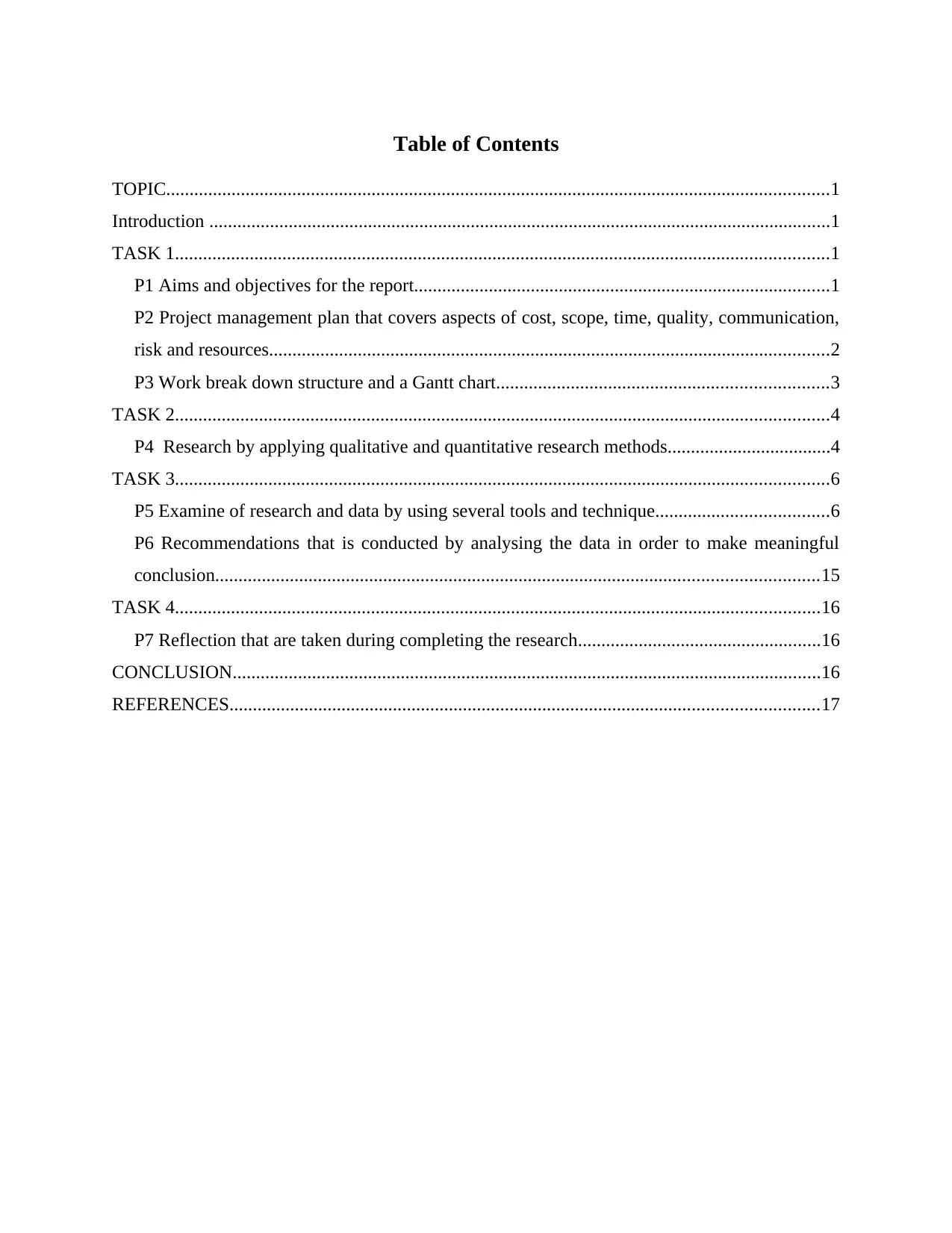
Table of Contents
TOPIC..............................................................................................................................................1
Introduction .....................................................................................................................................1
TASK 1............................................................................................................................................1
P1 Aims and objectives for the report.........................................................................................1
P2 Project management plan that covers aspects of cost, scope, time, quality, communication,
risk and resources........................................................................................................................2
P3 Work break down structure and a Gantt chart.......................................................................3
TASK 2............................................................................................................................................4
P4 Research by applying qualitative and quantitative research methods...................................4
TASK 3............................................................................................................................................6
P5 Examine of research and data by using several tools and technique.....................................6
P6 Recommendations that is conducted by analysing the data in order to make meaningful
conclusion.................................................................................................................................15
TASK 4..........................................................................................................................................16
P7 Reflection that are taken during completing the research....................................................16
CONCLUSION..............................................................................................................................16
REFERENCES..............................................................................................................................17
TOPIC..............................................................................................................................................1
Introduction .....................................................................................................................................1
TASK 1............................................................................................................................................1
P1 Aims and objectives for the report.........................................................................................1
P2 Project management plan that covers aspects of cost, scope, time, quality, communication,
risk and resources........................................................................................................................2
P3 Work break down structure and a Gantt chart.......................................................................3
TASK 2............................................................................................................................................4
P4 Research by applying qualitative and quantitative research methods...................................4
TASK 3............................................................................................................................................6
P5 Examine of research and data by using several tools and technique.....................................6
P6 Recommendations that is conducted by analysing the data in order to make meaningful
conclusion.................................................................................................................................15
TASK 4..........................................................................................................................................16
P7 Reflection that are taken during completing the research....................................................16
CONCLUSION..............................................................................................................................16
REFERENCES..............................................................................................................................17
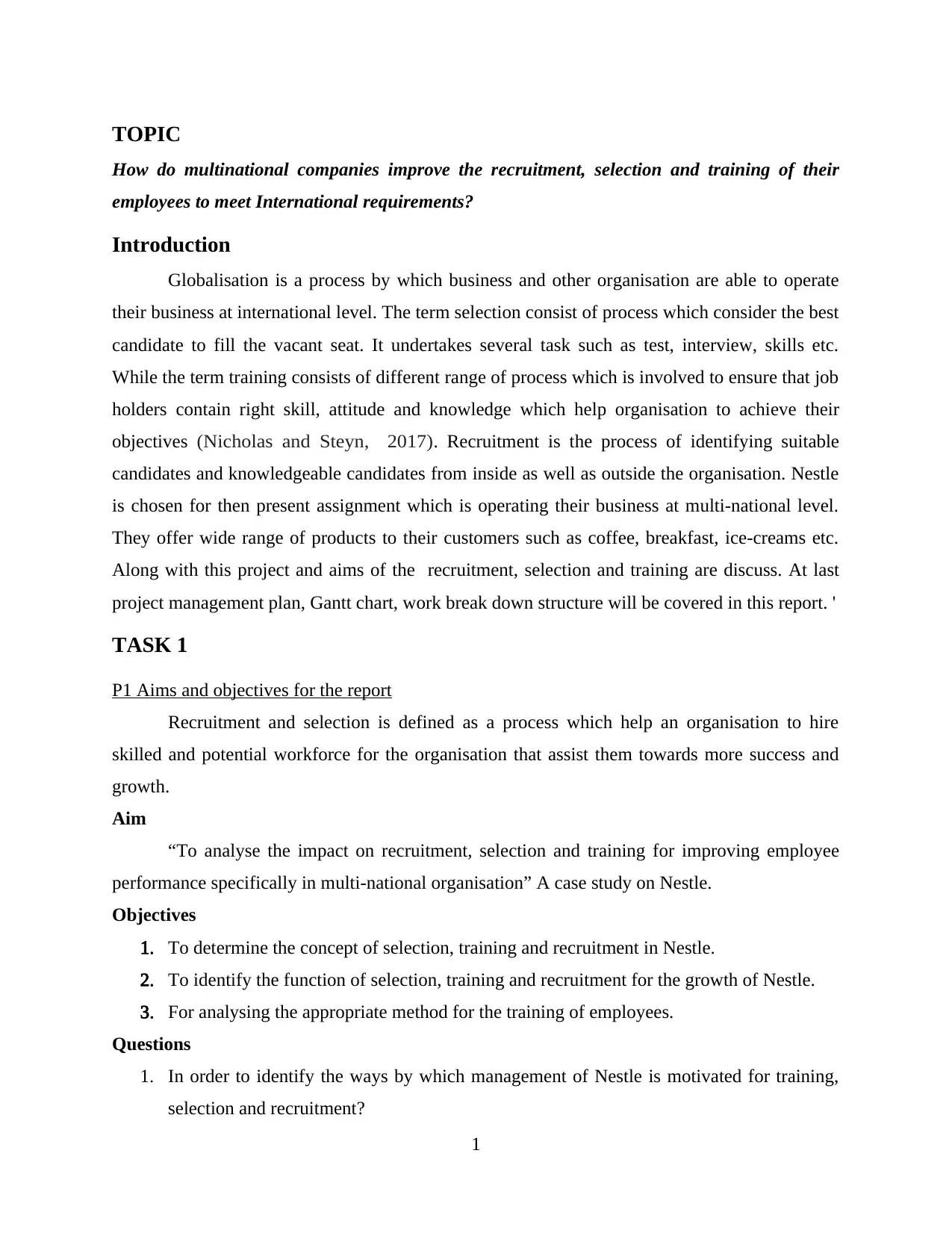
TOPIC
How do multinational companies improve the recruitment, selection and training of their
employees to meet International requirements?
Introduction
Globalisation is a process by which business and other organisation are able to operate
their business at international level. The term selection consist of process which consider the best
candidate to fill the vacant seat. It undertakes several task such as test, interview, skills etc.
While the term training consists of different range of process which is involved to ensure that job
holders contain right skill, attitude and knowledge which help organisation to achieve their
objectives (Nicholas and Steyn, 2017). Recruitment is the process of identifying suitable
candidates and knowledgeable candidates from inside as well as outside the organisation. Nestle
is chosen for then present assignment which is operating their business at multi-national level.
They offer wide range of products to their customers such as coffee, breakfast, ice-creams etc.
Along with this project and aims of the recruitment, selection and training are discuss. At last
project management plan, Gantt chart, work break down structure will be covered in this report. '
TASK 1
P1 Aims and objectives for the report
Recruitment and selection is defined as a process which help an organisation to hire
skilled and potential workforce for the organisation that assist them towards more success and
growth.
Aim
“To analyse the impact on recruitment, selection and training for improving employee
performance specifically in multi-national organisation” A case study on Nestle.
Objectives
1. To determine the concept of selection, training and recruitment in Nestle.
2. To identify the function of selection, training and recruitment for the growth of Nestle.
3. For analysing the appropriate method for the training of employees.
Questions
1. In order to identify the ways by which management of Nestle is motivated for training,
selection and recruitment?
1
How do multinational companies improve the recruitment, selection and training of their
employees to meet International requirements?
Introduction
Globalisation is a process by which business and other organisation are able to operate
their business at international level. The term selection consist of process which consider the best
candidate to fill the vacant seat. It undertakes several task such as test, interview, skills etc.
While the term training consists of different range of process which is involved to ensure that job
holders contain right skill, attitude and knowledge which help organisation to achieve their
objectives (Nicholas and Steyn, 2017). Recruitment is the process of identifying suitable
candidates and knowledgeable candidates from inside as well as outside the organisation. Nestle
is chosen for then present assignment which is operating their business at multi-national level.
They offer wide range of products to their customers such as coffee, breakfast, ice-creams etc.
Along with this project and aims of the recruitment, selection and training are discuss. At last
project management plan, Gantt chart, work break down structure will be covered in this report. '
TASK 1
P1 Aims and objectives for the report
Recruitment and selection is defined as a process which help an organisation to hire
skilled and potential workforce for the organisation that assist them towards more success and
growth.
Aim
“To analyse the impact on recruitment, selection and training for improving employee
performance specifically in multi-national organisation” A case study on Nestle.
Objectives
1. To determine the concept of selection, training and recruitment in Nestle.
2. To identify the function of selection, training and recruitment for the growth of Nestle.
3. For analysing the appropriate method for the training of employees.
Questions
1. In order to identify the ways by which management of Nestle is motivated for training,
selection and recruitment?
1
⊘ This is a preview!⊘
Do you want full access?
Subscribe today to unlock all pages.

Trusted by 1+ million students worldwide
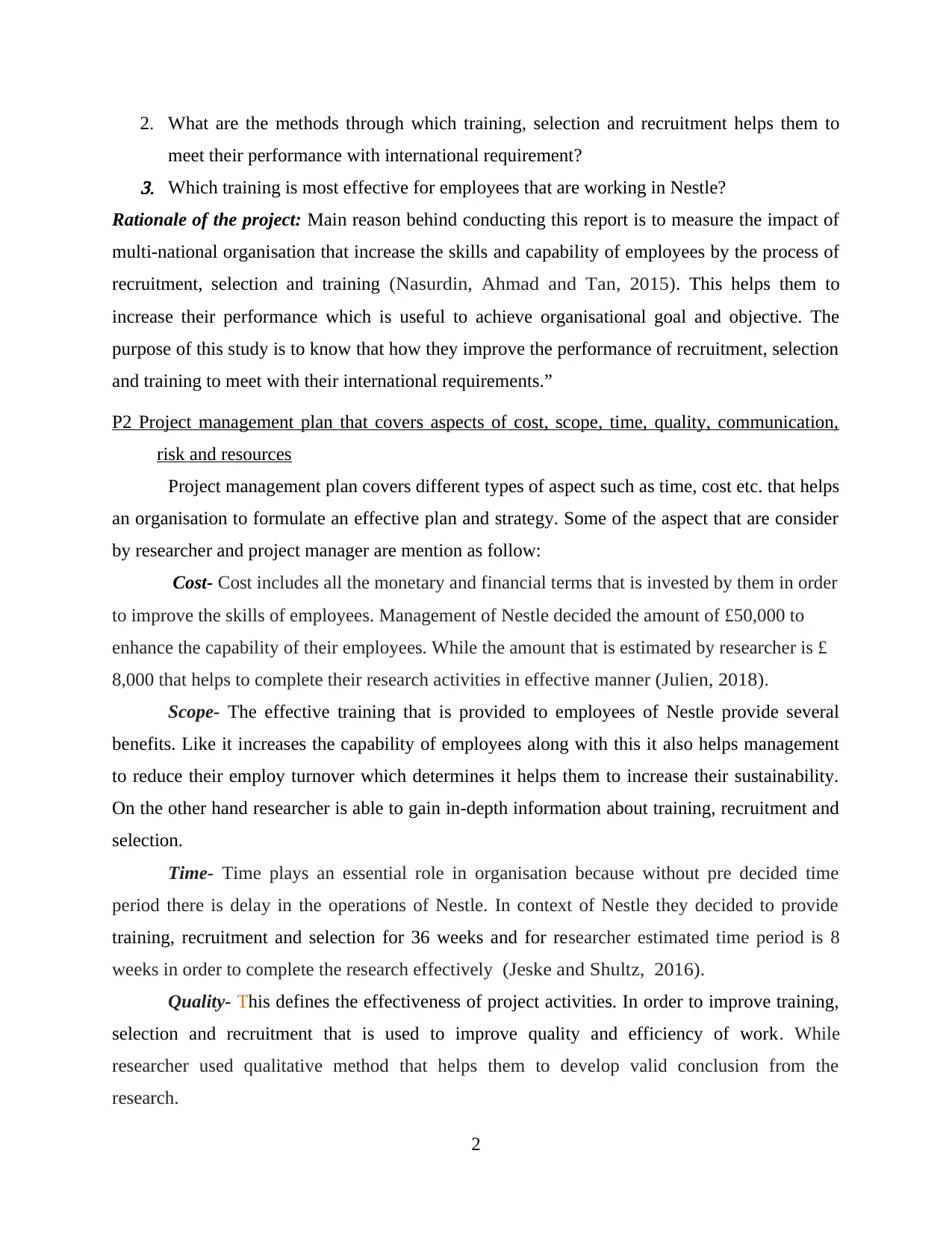
2. What are the methods through which training, selection and recruitment helps them to
meet their performance with international requirement?3. Which training is most effective for employees that are working in Nestle?
Rationale of the project: Main reason behind conducting this report is to measure the impact of
multi-national organisation that increase the skills and capability of employees by the process of
recruitment, selection and training (Nasurdin, Ahmad and Tan, 2015). This helps them to
increase their performance which is useful to achieve organisational goal and objective. The
purpose of this study is to know that how they improve the performance of recruitment, selection
and training to meet with their international requirements.”
P2 Project management plan that covers aspects of cost, scope, time, quality, communication,
risk and resources
Project management plan covers different types of aspect such as time, cost etc. that helps
an organisation to formulate an effective plan and strategy. Some of the aspect that are consider
by researcher and project manager are mention as follow:
Cost- Cost includes all the monetary and financial terms that is invested by them in order
to improve the skills of employees. Management of Nestle decided the amount of £50,000 to
enhance the capability of their employees. While the amount that is estimated by researcher is £
8,000 that helps to complete their research activities in effective manner (Julien, 2018).
Scope- The effective training that is provided to employees of Nestle provide several
benefits. Like it increases the capability of employees along with this it also helps management
to reduce their employ turnover which determines it helps them to increase their sustainability.
On the other hand researcher is able to gain in-depth information about training, recruitment and
selection.
Time- Time plays an essential role in organisation because without pre decided time
period there is delay in the operations of Nestle. In context of Nestle they decided to provide
training, recruitment and selection for 36 weeks and for researcher estimated time period is 8
weeks in order to complete the research effectively (Jeske and Shultz, 2016).
Quality- This defines the effectiveness of project activities. In order to improve training,
selection and recruitment that is used to improve quality and efficiency of work. While
researcher used qualitative method that helps them to develop valid conclusion from the
research.
2
meet their performance with international requirement?3. Which training is most effective for employees that are working in Nestle?
Rationale of the project: Main reason behind conducting this report is to measure the impact of
multi-national organisation that increase the skills and capability of employees by the process of
recruitment, selection and training (Nasurdin, Ahmad and Tan, 2015). This helps them to
increase their performance which is useful to achieve organisational goal and objective. The
purpose of this study is to know that how they improve the performance of recruitment, selection
and training to meet with their international requirements.”
P2 Project management plan that covers aspects of cost, scope, time, quality, communication,
risk and resources
Project management plan covers different types of aspect such as time, cost etc. that helps
an organisation to formulate an effective plan and strategy. Some of the aspect that are consider
by researcher and project manager are mention as follow:
Cost- Cost includes all the monetary and financial terms that is invested by them in order
to improve the skills of employees. Management of Nestle decided the amount of £50,000 to
enhance the capability of their employees. While the amount that is estimated by researcher is £
8,000 that helps to complete their research activities in effective manner (Julien, 2018).
Scope- The effective training that is provided to employees of Nestle provide several
benefits. Like it increases the capability of employees along with this it also helps management
to reduce their employ turnover which determines it helps them to increase their sustainability.
On the other hand researcher is able to gain in-depth information about training, recruitment and
selection.
Time- Time plays an essential role in organisation because without pre decided time
period there is delay in the operations of Nestle. In context of Nestle they decided to provide
training, recruitment and selection for 36 weeks and for researcher estimated time period is 8
weeks in order to complete the research effectively (Jeske and Shultz, 2016).
Quality- This defines the effectiveness of project activities. In order to improve training,
selection and recruitment that is used to improve quality and efficiency of work. While
researcher used qualitative method that helps them to develop valid conclusion from the
research.
2
Paraphrase This Document
Need a fresh take? Get an instant paraphrase of this document with our AI Paraphraser
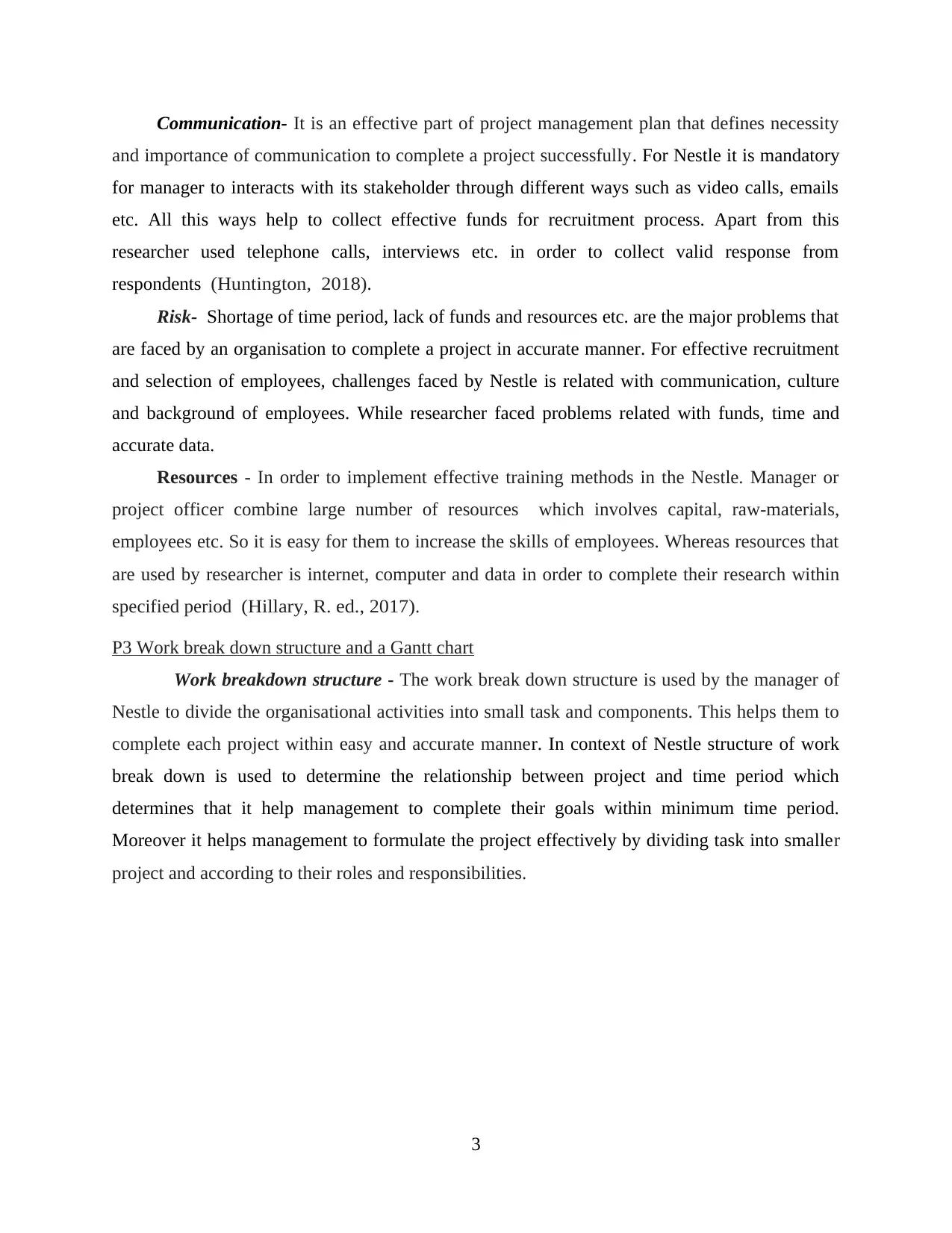
Communication- It is an effective part of project management plan that defines necessity
and importance of communication to complete a project successfully. For Nestle it is mandatory
for manager to interacts with its stakeholder through different ways such as video calls, emails
etc. All this ways help to collect effective funds for recruitment process. Apart from this
researcher used telephone calls, interviews etc. in order to collect valid response from
respondents (Huntington, 2018).
Risk- Shortage of time period, lack of funds and resources etc. are the major problems that
are faced by an organisation to complete a project in accurate manner. For effective recruitment
and selection of employees, challenges faced by Nestle is related with communication, culture
and background of employees. While researcher faced problems related with funds, time and
accurate data.
Resources - In order to implement effective training methods in the Nestle. Manager or
project officer combine large number of resources which involves capital, raw-materials,
employees etc. So it is easy for them to increase the skills of employees. Whereas resources that
are used by researcher is internet, computer and data in order to complete their research within
specified period (Hillary, R. ed., 2017).
P3 Work break down structure and a Gantt chart
Work breakdown structure - The work break down structure is used by the manager of
Nestle to divide the organisational activities into small task and components. This helps them to
complete each project within easy and accurate manner. In context of Nestle structure of work
break down is used to determine the relationship between project and time period which
determines that it help management to complete their goals within minimum time period.
Moreover it helps management to formulate the project effectively by dividing task into smaller
project and according to their roles and responsibilities.
3
and importance of communication to complete a project successfully. For Nestle it is mandatory
for manager to interacts with its stakeholder through different ways such as video calls, emails
etc. All this ways help to collect effective funds for recruitment process. Apart from this
researcher used telephone calls, interviews etc. in order to collect valid response from
respondents (Huntington, 2018).
Risk- Shortage of time period, lack of funds and resources etc. are the major problems that
are faced by an organisation to complete a project in accurate manner. For effective recruitment
and selection of employees, challenges faced by Nestle is related with communication, culture
and background of employees. While researcher faced problems related with funds, time and
accurate data.
Resources - In order to implement effective training methods in the Nestle. Manager or
project officer combine large number of resources which involves capital, raw-materials,
employees etc. So it is easy for them to increase the skills of employees. Whereas resources that
are used by researcher is internet, computer and data in order to complete their research within
specified period (Hillary, R. ed., 2017).
P3 Work break down structure and a Gantt chart
Work breakdown structure - The work break down structure is used by the manager of
Nestle to divide the organisational activities into small task and components. This helps them to
complete each project within easy and accurate manner. In context of Nestle structure of work
break down is used to determine the relationship between project and time period which
determines that it help management to complete their goals within minimum time period.
Moreover it helps management to formulate the project effectively by dividing task into smaller
project and according to their roles and responsibilities.
3
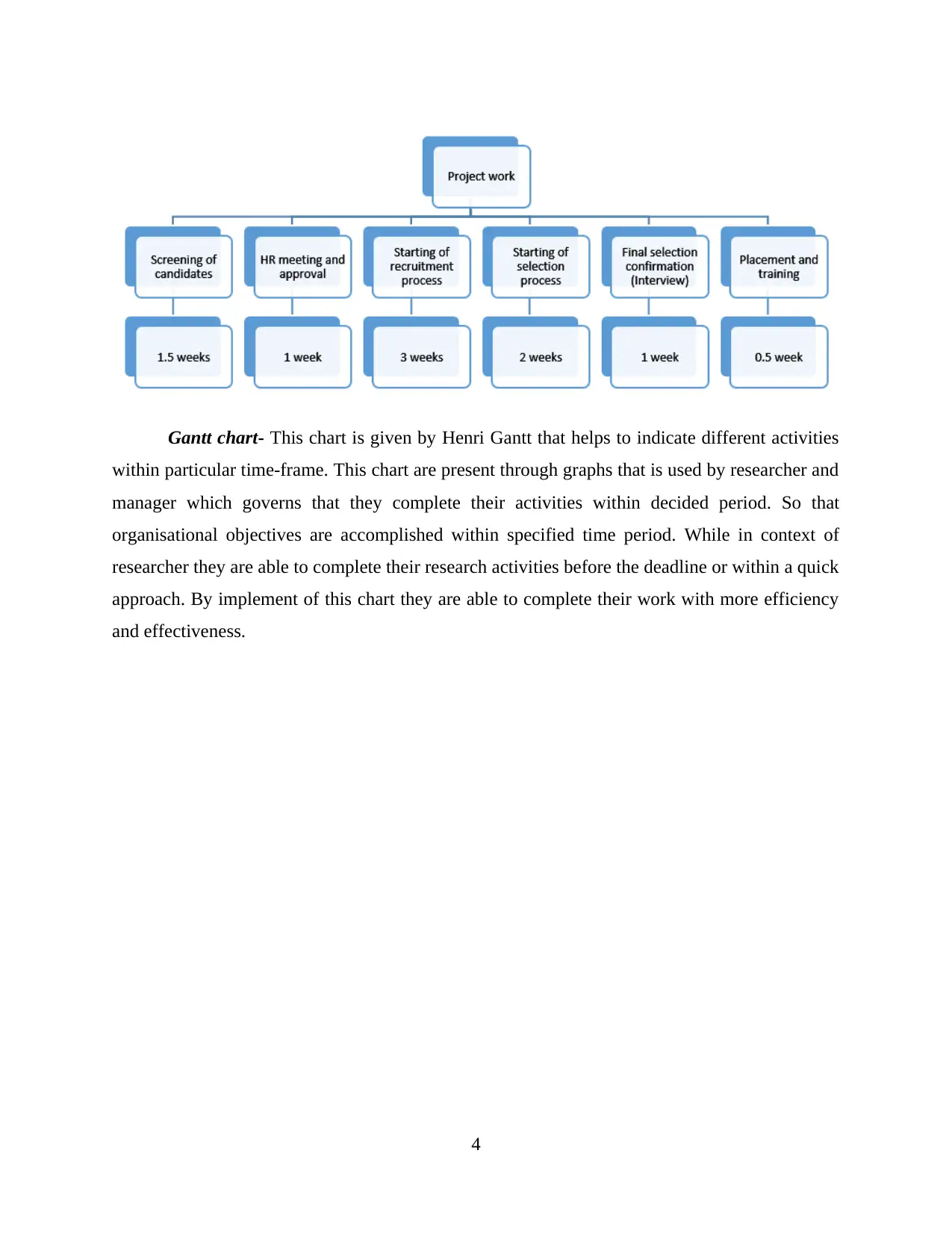
Gantt chart- This chart is given by Henri Gantt that helps to indicate different activities
within particular time-frame. This chart are present through graphs that is used by researcher and
manager which governs that they complete their activities within decided period. So that
organisational objectives are accomplished within specified time period. While in context of
researcher they are able to complete their research activities before the deadline or within a quick
approach. By implement of this chart they are able to complete their work with more efficiency
and effectiveness.
4
within particular time-frame. This chart are present through graphs that is used by researcher and
manager which governs that they complete their activities within decided period. So that
organisational objectives are accomplished within specified time period. While in context of
researcher they are able to complete their research activities before the deadline or within a quick
approach. By implement of this chart they are able to complete their work with more efficiency
and effectiveness.
4
⊘ This is a preview!⊘
Do you want full access?
Subscribe today to unlock all pages.

Trusted by 1+ million students worldwide
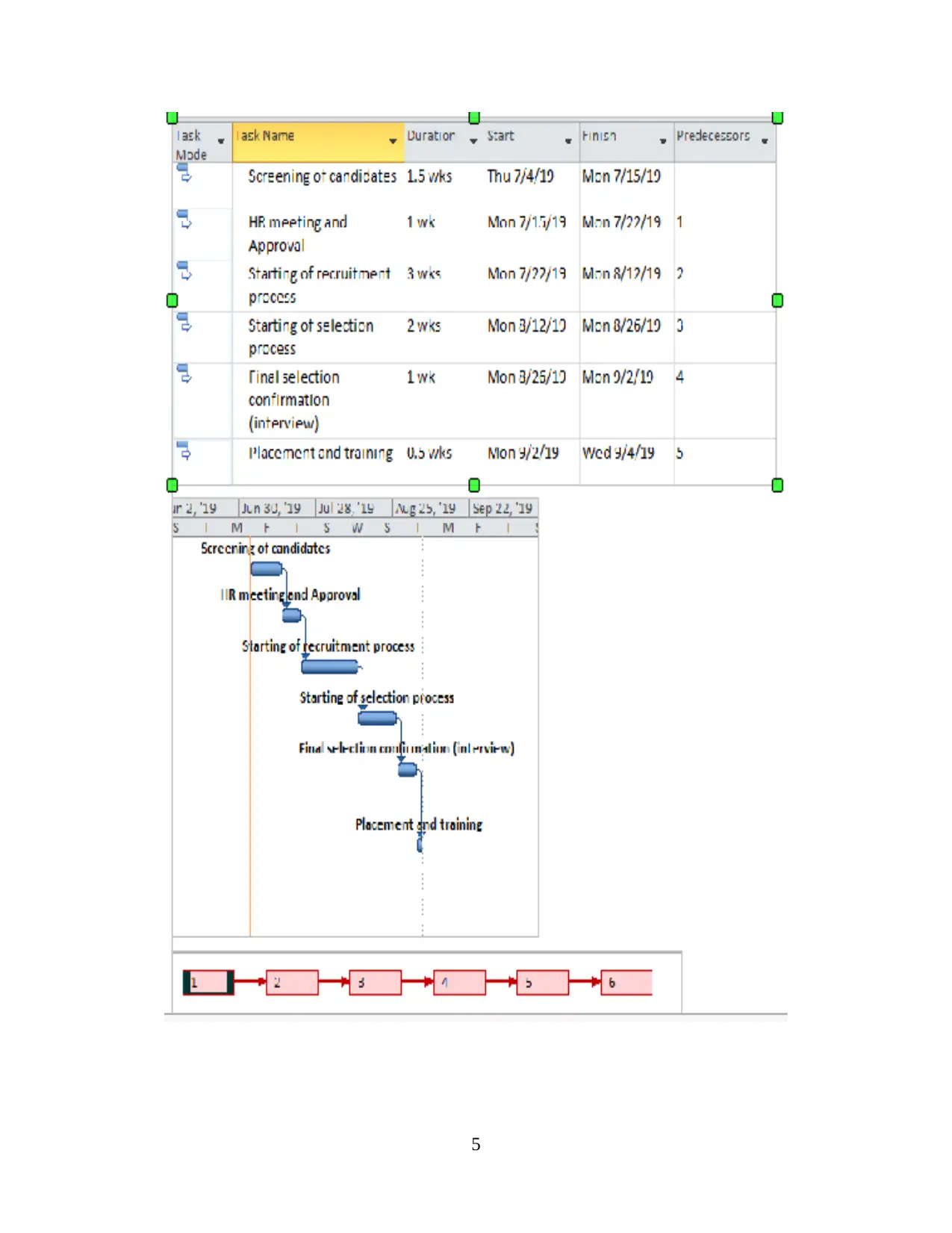
5
Paraphrase This Document
Need a fresh take? Get an instant paraphrase of this document with our AI Paraphraser
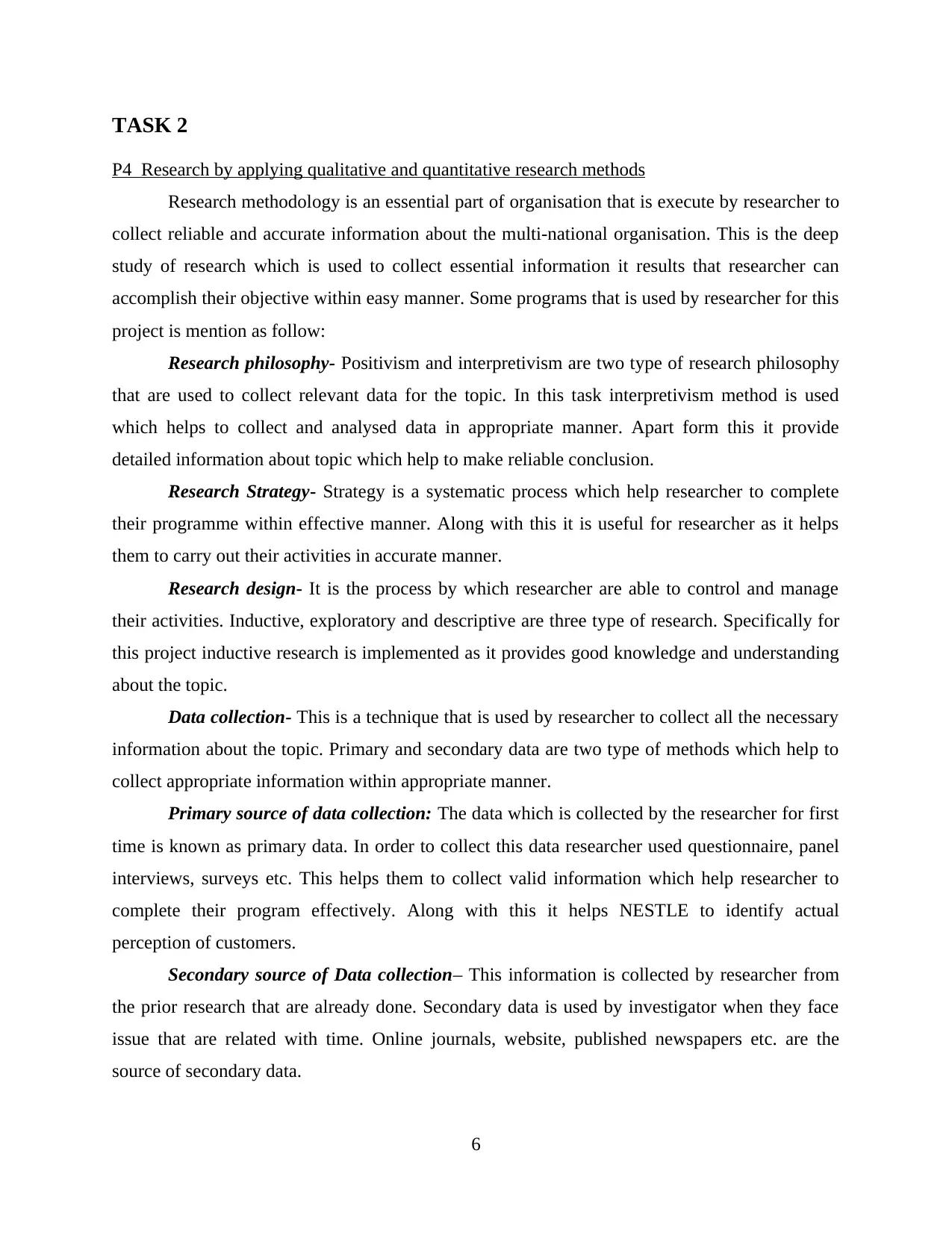
TASK 2
P4 Research by applying qualitative and quantitative research methods
Research methodology is an essential part of organisation that is execute by researcher to
collect reliable and accurate information about the multi-national organisation. This is the deep
study of research which is used to collect essential information it results that researcher can
accomplish their objective within easy manner. Some programs that is used by researcher for this
project is mention as follow:
Research philosophy- Positivism and interpretivism are two type of research philosophy
that are used to collect relevant data for the topic. In this task interpretivism method is used
which helps to collect and analysed data in appropriate manner. Apart form this it provide
detailed information about topic which help to make reliable conclusion.
Research Strategy- Strategy is a systematic process which help researcher to complete
their programme within effective manner. Along with this it is useful for researcher as it helps
them to carry out their activities in accurate manner.
Research design- It is the process by which researcher are able to control and manage
their activities. Inductive, exploratory and descriptive are three type of research. Specifically for
this project inductive research is implemented as it provides good knowledge and understanding
about the topic.
Data collection- This is a technique that is used by researcher to collect all the necessary
information about the topic. Primary and secondary data are two type of methods which help to
collect appropriate information within appropriate manner.
Primary source of data collection: The data which is collected by the researcher for first
time is known as primary data. In order to collect this data researcher used questionnaire, panel
interviews, surveys etc. This helps them to collect valid information which help researcher to
complete their program effectively. Along with this it helps NESTLE to identify actual
perception of customers.
Secondary source of Data collection– This information is collected by researcher from
the prior research that are already done. Secondary data is used by investigator when they face
issue that are related with time. Online journals, website, published newspapers etc. are the
source of secondary data.
6
P4 Research by applying qualitative and quantitative research methods
Research methodology is an essential part of organisation that is execute by researcher to
collect reliable and accurate information about the multi-national organisation. This is the deep
study of research which is used to collect essential information it results that researcher can
accomplish their objective within easy manner. Some programs that is used by researcher for this
project is mention as follow:
Research philosophy- Positivism and interpretivism are two type of research philosophy
that are used to collect relevant data for the topic. In this task interpretivism method is used
which helps to collect and analysed data in appropriate manner. Apart form this it provide
detailed information about topic which help to make reliable conclusion.
Research Strategy- Strategy is a systematic process which help researcher to complete
their programme within effective manner. Along with this it is useful for researcher as it helps
them to carry out their activities in accurate manner.
Research design- It is the process by which researcher are able to control and manage
their activities. Inductive, exploratory and descriptive are three type of research. Specifically for
this project inductive research is implemented as it provides good knowledge and understanding
about the topic.
Data collection- This is a technique that is used by researcher to collect all the necessary
information about the topic. Primary and secondary data are two type of methods which help to
collect appropriate information within appropriate manner.
Primary source of data collection: The data which is collected by the researcher for first
time is known as primary data. In order to collect this data researcher used questionnaire, panel
interviews, surveys etc. This helps them to collect valid information which help researcher to
complete their program effectively. Along with this it helps NESTLE to identify actual
perception of customers.
Secondary source of Data collection– This information is collected by researcher from
the prior research that are already done. Secondary data is used by investigator when they face
issue that are related with time. Online journals, website, published newspapers etc. are the
source of secondary data.
6
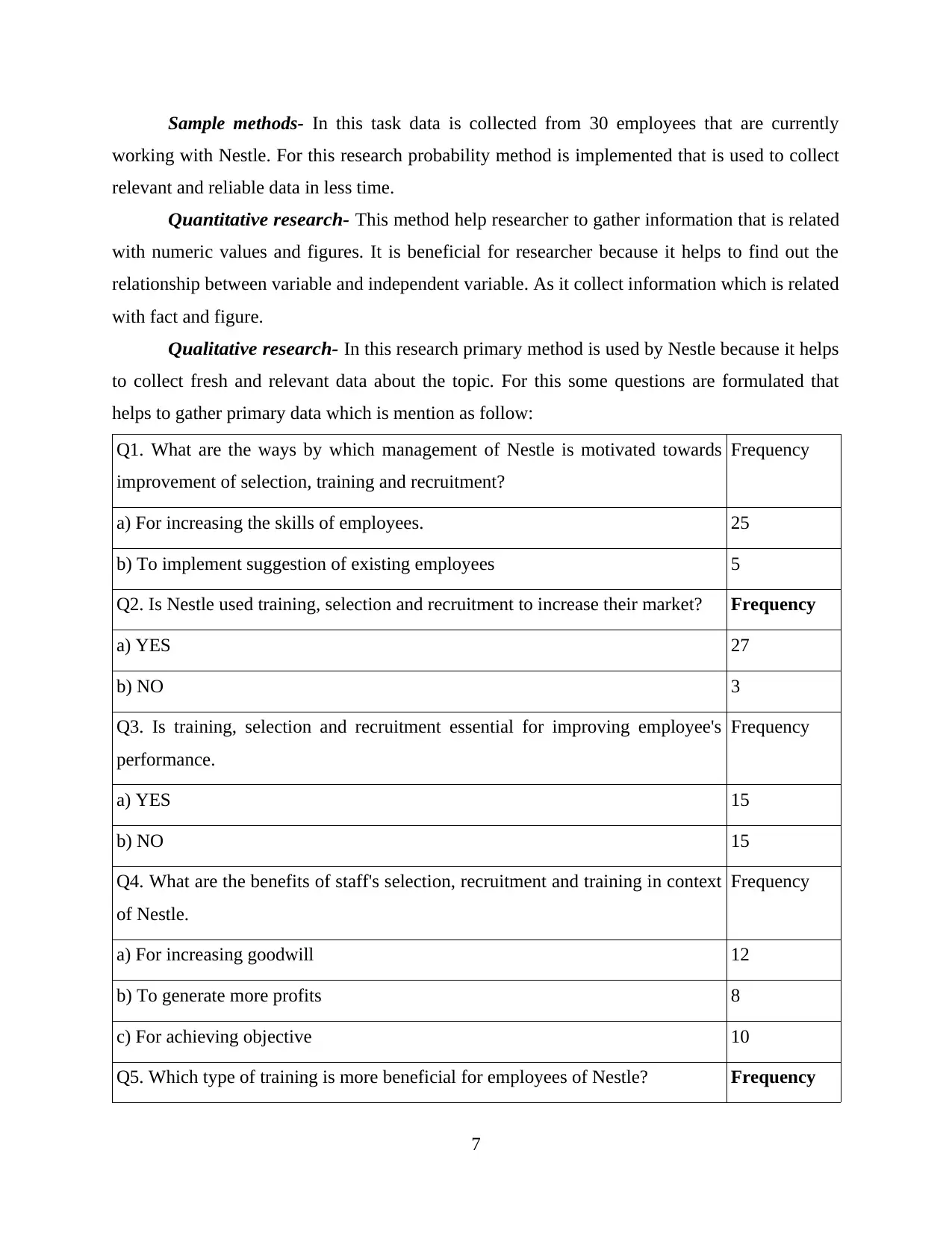
Sample methods- In this task data is collected from 30 employees that are currently
working with Nestle. For this research probability method is implemented that is used to collect
relevant and reliable data in less time.
Quantitative research- This method help researcher to gather information that is related
with numeric values and figures. It is beneficial for researcher because it helps to find out the
relationship between variable and independent variable. As it collect information which is related
with fact and figure.
Qualitative research- In this research primary method is used by Nestle because it helps
to collect fresh and relevant data about the topic. For this some questions are formulated that
helps to gather primary data which is mention as follow:
Q1. What are the ways by which management of Nestle is motivated towards
improvement of selection, training and recruitment?
Frequency
a) For increasing the skills of employees. 25
b) To implement suggestion of existing employees 5
Q2. Is Nestle used training, selection and recruitment to increase their market? Frequency
a) YES 27
b) NO 3
Q3. Is training, selection and recruitment essential for improving employee's
performance.
Frequency
a) YES 15
b) NO 15
Q4. What are the benefits of staff's selection, recruitment and training in context
of Nestle.
Frequency
a) For increasing goodwill 12
b) To generate more profits 8
c) For achieving objective 10
Q5. Which type of training is more beneficial for employees of Nestle? Frequency
7
working with Nestle. For this research probability method is implemented that is used to collect
relevant and reliable data in less time.
Quantitative research- This method help researcher to gather information that is related
with numeric values and figures. It is beneficial for researcher because it helps to find out the
relationship between variable and independent variable. As it collect information which is related
with fact and figure.
Qualitative research- In this research primary method is used by Nestle because it helps
to collect fresh and relevant data about the topic. For this some questions are formulated that
helps to gather primary data which is mention as follow:
Q1. What are the ways by which management of Nestle is motivated towards
improvement of selection, training and recruitment?
Frequency
a) For increasing the skills of employees. 25
b) To implement suggestion of existing employees 5
Q2. Is Nestle used training, selection and recruitment to increase their market? Frequency
a) YES 27
b) NO 3
Q3. Is training, selection and recruitment essential for improving employee's
performance.
Frequency
a) YES 15
b) NO 15
Q4. What are the benefits of staff's selection, recruitment and training in context
of Nestle.
Frequency
a) For increasing goodwill 12
b) To generate more profits 8
c) For achieving objective 10
Q5. Which type of training is more beneficial for employees of Nestle? Frequency
7
⊘ This is a preview!⊘
Do you want full access?
Subscribe today to unlock all pages.

Trusted by 1+ million students worldwide
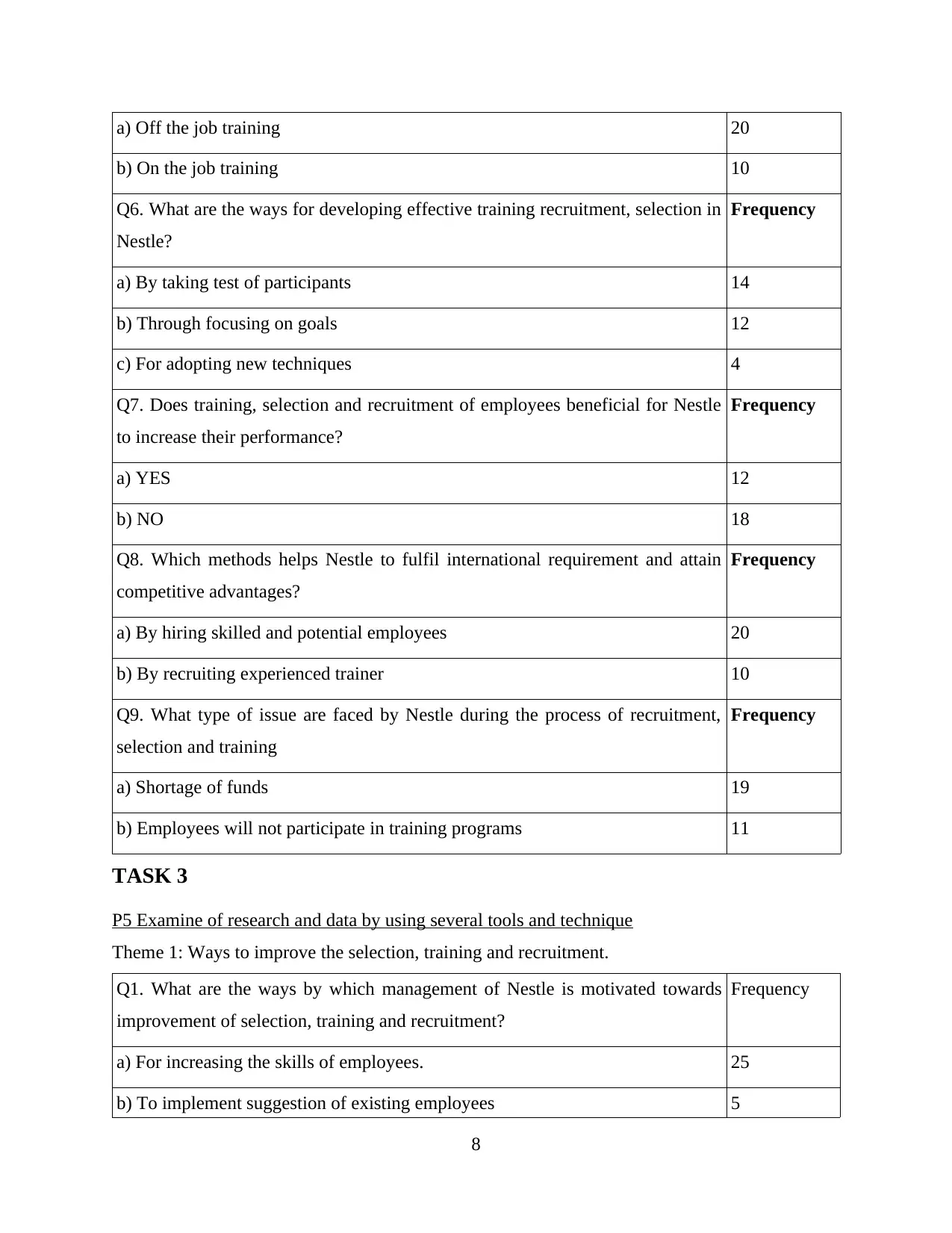
a) Off the job training 20
b) On the job training 10
Q6. What are the ways for developing effective training recruitment, selection in
Nestle?
Frequency
a) By taking test of participants 14
b) Through focusing on goals 12
c) For adopting new techniques 4
Q7. Does training, selection and recruitment of employees beneficial for Nestle
to increase their performance?
Frequency
a) YES 12
b) NO 18
Q8. Which methods helps Nestle to fulfil international requirement and attain
competitive advantages?
Frequency
a) By hiring skilled and potential employees 20
b) By recruiting experienced trainer 10
Q9. What type of issue are faced by Nestle during the process of recruitment,
selection and training
Frequency
a) Shortage of funds 19
b) Employees will not participate in training programs 11
TASK 3
P5 Examine of research and data by using several tools and technique
Theme 1: Ways to improve the selection, training and recruitment.
Q1. What are the ways by which management of Nestle is motivated towards
improvement of selection, training and recruitment?
Frequency
a) For increasing the skills of employees. 25
b) To implement suggestion of existing employees 5
8
b) On the job training 10
Q6. What are the ways for developing effective training recruitment, selection in
Nestle?
Frequency
a) By taking test of participants 14
b) Through focusing on goals 12
c) For adopting new techniques 4
Q7. Does training, selection and recruitment of employees beneficial for Nestle
to increase their performance?
Frequency
a) YES 12
b) NO 18
Q8. Which methods helps Nestle to fulfil international requirement and attain
competitive advantages?
Frequency
a) By hiring skilled and potential employees 20
b) By recruiting experienced trainer 10
Q9. What type of issue are faced by Nestle during the process of recruitment,
selection and training
Frequency
a) Shortage of funds 19
b) Employees will not participate in training programs 11
TASK 3
P5 Examine of research and data by using several tools and technique
Theme 1: Ways to improve the selection, training and recruitment.
Q1. What are the ways by which management of Nestle is motivated towards
improvement of selection, training and recruitment?
Frequency
a) For increasing the skills of employees. 25
b) To implement suggestion of existing employees 5
8
Paraphrase This Document
Need a fresh take? Get an instant paraphrase of this document with our AI Paraphraser
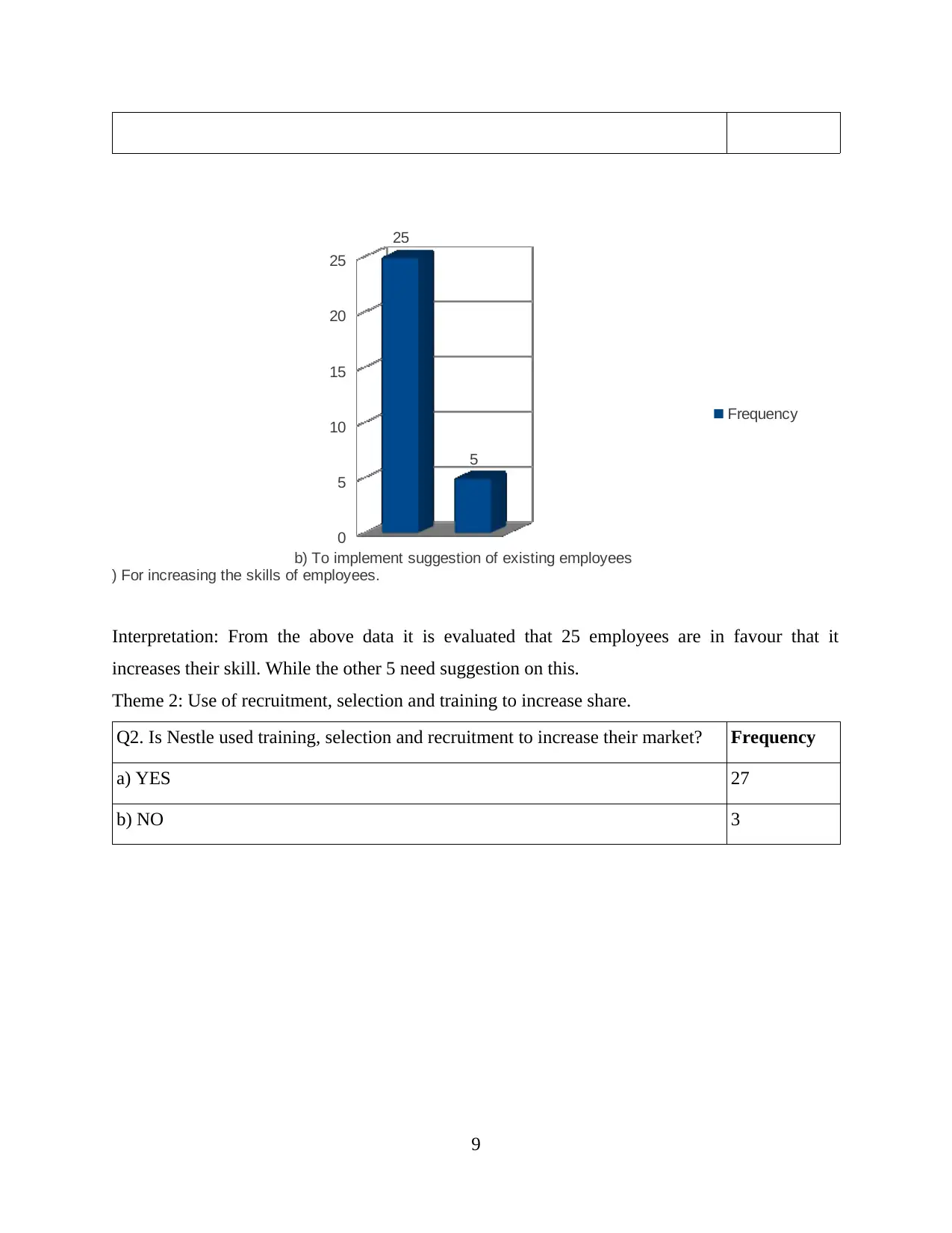
a) For increasing the skills of employees.
b) To implement suggestion of existing employees
0
5
10
15
20
25
25
5
Frequency
Interpretation: From the above data it is evaluated that 25 employees are in favour that it
increases their skill. While the other 5 need suggestion on this.
Theme 2: Use of recruitment, selection and training to increase share.
Q2. Is Nestle used training, selection and recruitment to increase their market? Frequency
a) YES 27
b) NO 3
9
b) To implement suggestion of existing employees
0
5
10
15
20
25
25
5
Frequency
Interpretation: From the above data it is evaluated that 25 employees are in favour that it
increases their skill. While the other 5 need suggestion on this.
Theme 2: Use of recruitment, selection and training to increase share.
Q2. Is Nestle used training, selection and recruitment to increase their market? Frequency
a) YES 27
b) NO 3
9
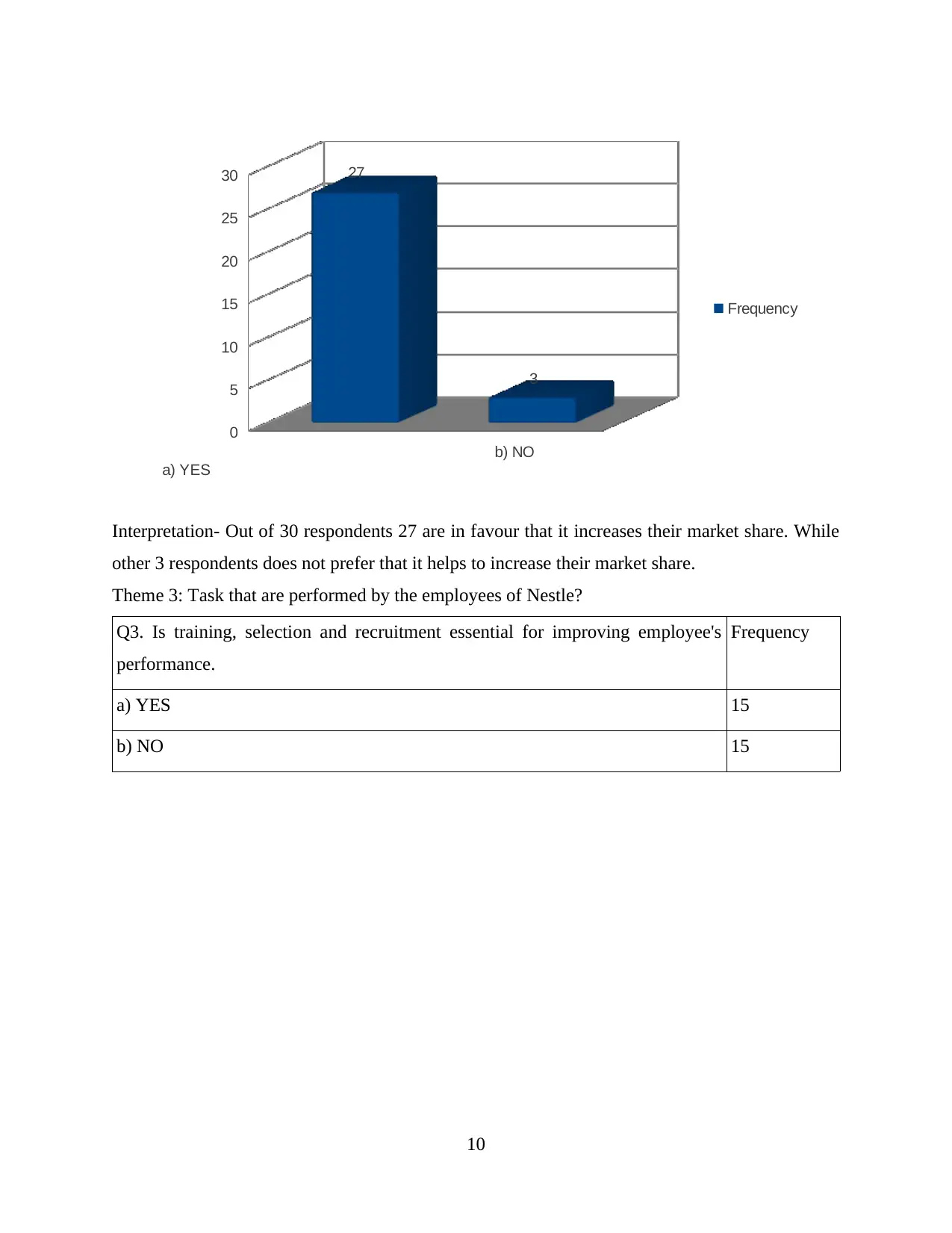
a) YES
b) NO
0
5
10
15
20
25
30 27
3
Frequency
Interpretation- Out of 30 respondents 27 are in favour that it increases their market share. While
other 3 respondents does not prefer that it helps to increase their market share.
Theme 3: Task that are performed by the employees of Nestle?
Q3. Is training, selection and recruitment essential for improving employee's
performance.
Frequency
a) YES 15
b) NO 15
10
b) NO
0
5
10
15
20
25
30 27
3
Frequency
Interpretation- Out of 30 respondents 27 are in favour that it increases their market share. While
other 3 respondents does not prefer that it helps to increase their market share.
Theme 3: Task that are performed by the employees of Nestle?
Q3. Is training, selection and recruitment essential for improving employee's
performance.
Frequency
a) YES 15
b) NO 15
10
⊘ This is a preview!⊘
Do you want full access?
Subscribe today to unlock all pages.

Trusted by 1+ million students worldwide
1 out of 22
Related Documents
Your All-in-One AI-Powered Toolkit for Academic Success.
+13062052269
info@desklib.com
Available 24*7 on WhatsApp / Email
![[object Object]](/_next/static/media/star-bottom.7253800d.svg)
Unlock your academic potential
Copyright © 2020–2025 A2Z Services. All Rights Reserved. Developed and managed by ZUCOL.





